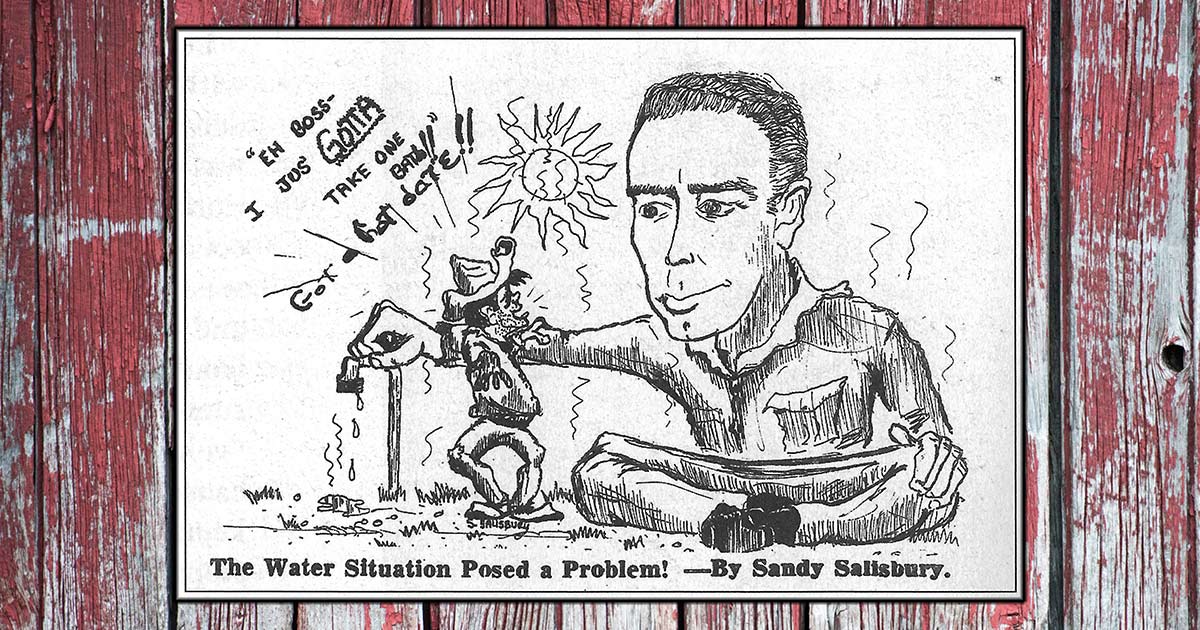
Cartoon of Rally Greenwell, General Manager – Parker Ranch
We asked Dr. Billy Bergin for his thoughts on how our paniolo community has faced extreme difficulties in the past. For those of you who don’t know historian, author, raconteur and 25-year Parker Ranch veterinarian “Dr. B,” he’s pretty much a walking encyclopedia of everything Waimea. What he first recalled were times of drought.
“In the very late 1800’s, a severe drought affected the Waimea area at a time when the native population was entirely dependent on the three streams: the Lanimaomao, Waikoloa and Kohakohau waterways. Lack of water for livestock and villagers created a central crises, but famine came when the auwai system that served the Waimea Field System dried up, and sweet potato, dry land taro and other food crops were out of production. Waipi‘o, which provided most of the poi, was affected by the drought, but not entirely devoid of water flow. This saved many lives, not only in Hamakua, but Waimea which was at the time a collection of 7-8 small hamlets.
“The early 1900’s saw cyclical droughts of 2-3 years in length. Thanks to the leadership of AW Carter of Parker Ranch, water reserves, albeit rudimentary, were developed for the good of the community as well as the expanding cattle and horse numbers. Carter brought in world-renown hydrologists to explore collection and transport of the high elevation water resources of the Kohala Mountain Range. He further utilized the advice of native Hawaiian seers and confidants who directed efforts toward utilizing remote spring resources. Sam “Puna” Kauwe was one of those who directed attention to one such place, Waiakamakapo, known to be a dependable, albeit moderate water resource.
“But then in the 1960’s, there was a drought so severe that many elders today, especially senior Parker Ranch personnel, recall it as tragic—for both the community (bathing curtailed) and livestock (serious losses). Bill Case, retired water superintendent, shared that the outflow of the verdant Kohala Mountain Range was reduced to a slurry of watery mud, and yet cattle could hydrate to survive. Crews carried aluminum irrigation piping into the mountains, to tap ponds within gravitational reach, and thus divert water to the ranch water heads high above Waimea town.
“By this time, the State of Hawai‘i finally executed comprehensive water resource development. These plans brought relief to Waimea Town and its highly productive truck farming industry. It must be stated at this juncture, that Parker Ranch, under the leadership of Rally Greenwell (and of course his predecessors, the Carters and Richard Penhallow), developed over 200 million additional gallons of ground water storage all over the Ranch. These collective water resources were shared at no cost to the nearly 50 Department of Hawaiian Home Lands ranchers, until State and County resources were developed.”
Even during those tough times, people rallied; people in leadership had the foresight and heart to take their stewardship of the land seriously. As a result, the entire community was helped. We’re confident our community will continue to move ahead, with resilience, and a strong spirit of aloha. Keep well!
